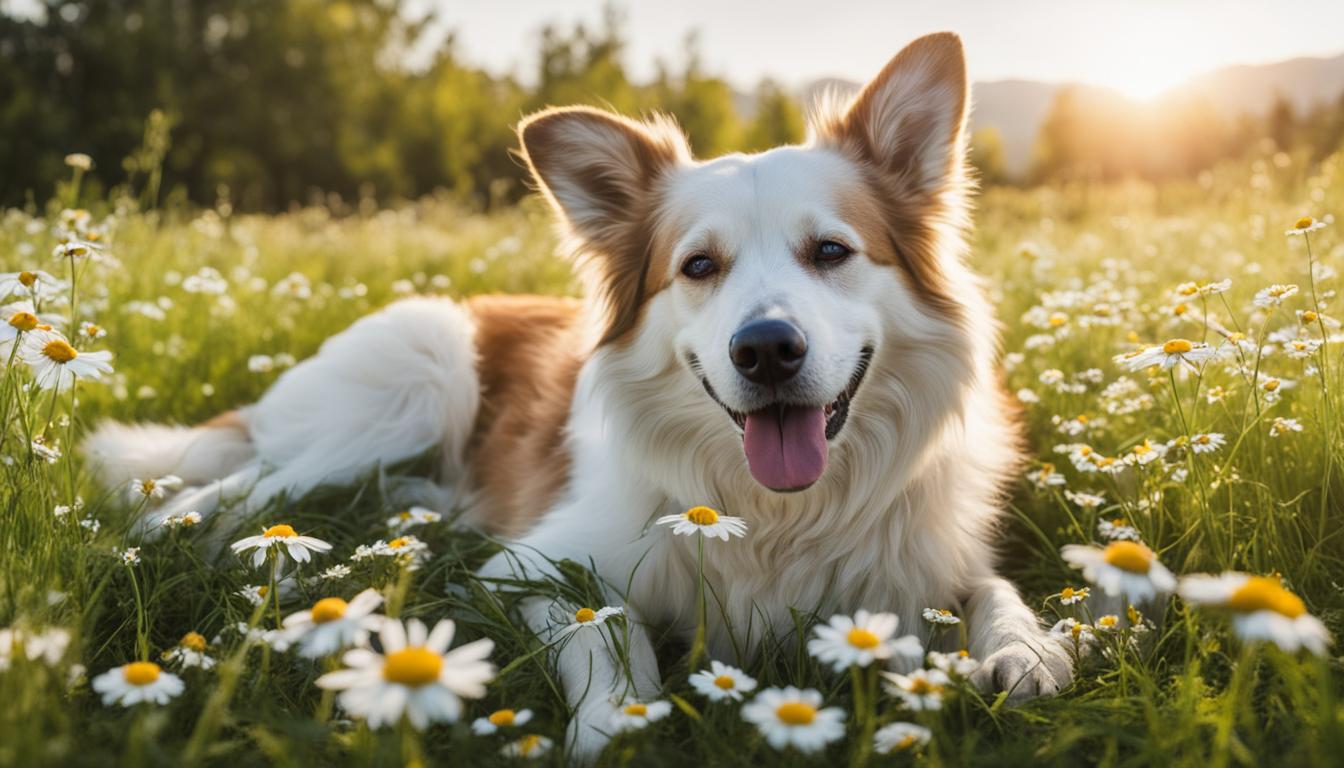If your furry buddy is scratching a lot or biting their skin, they may have hives. Hives are red, puffy spots that can appear anywhere on a dog’s body, like their face or legs. They are really itchy and can make your dog feel uncomfortable. If you see this, take them to a vet first to find out what’s causing the problem, often an allergy. Though the vet might suggest some medicine, there are also safe, natural ways you can help at home. Things like oat baths, herbal teas, and a mix of apple cider vinegar and water can offer quick comfort and help with dog hives treatment, providing natural dog hives remedy, skin irritation relief, and soothing swollen welts due to canine allergic reactions.
Key Takeaways
- Natural remedies can ease your dog’s itchy hives.
- Oat baths cool down and relieve swollen, red welts.
- Herbal teas can be a gentle way to help your furry friend.
- Apple cider vinegar and water mix can work wonders for quick relief.
- Always check with your vet before trying home treatments.
Deciphering Dog Hives: Symptoms and Causes
When your dog starts scratching a lot and you see red patches on their skin, they might have something called hives. If their face looks puffy, or they keep biting at their paws, these might be signs your furry friend is dealing with hives. Sometimes, you can even see the hives as raised spots on their skin. It’s not fun for them, and you’ll want to help them feel better. Let’s learn how to spot the signs of hives and understand what might cause them.
Recognizing Symptoms of Dog Hives
Hives on dogs can look like little bumps or swollen areas, and they can show up anywhere on your dog’s body. Your dog might be really itchy, scratch a lot, or act like they’re uncomfortable. Keep an eye out for things like redness, swelling – especially on their face – and itchiness. These are often signs of allergy-induced hives. If your dog’s face is puffy and they are having trouble seeing or breathing, you should take them to the vet right away!
Exploring Common Causes of Hives in Dogs
So, what can make dogs get hives? It’s usually because they’re allergic to something. This could be a bug bite or sting, a new medicine, or even plants outside like poison ivy. Just like some humans get sneezy or itchy when they’re around things they’re allergic to, dogs can have allergic reactions that cause hives.
Identifying Allergens Linked to Dog Hives
Figuring out what causes hives on your dog is important for keeping them happy and itch-free. It could be their food, plants they ran into during their walk, or even a new shampoo. If you notice they get hives after being around certain things, they might be allergic to them. Try to keep them away from these allergen triggers. With a bit of detective work and some simple allergen avoidance strategies, you can help your dog stay clear of those pesky hives.
Immediate Steps: Consultation and Diagnosis
If your dog has bumps on their skin, it might mean they have hives. This can be itchy for them and make them rub their skin a lot. It’s smart to go see a vet if you think your dog has hives. Vets know a lot about animals and can help find out what’s causing the itchiness. They’ll look at your dog and ask you questions to figure out why your dog has hives. Sometimes, they might need to give your dog medicine to make them feel better.
Getting help from a vet is the first thing to do when your dog has skin trouble. Vets are good at assessing allergic responses in pets and can give you the best veterinary advice. When you go to the vet, they might use special tools and tests to find out more about your dog’s skin problems, which is called a dog skin irritation diagnosis.
- Look closely at your dog’s skin: They will check the red areas and bumps.
- Ask about your dog’s home: They will want to know where your dog goes and what they eat.
- Think about any new things: They will consider if there are any new foods or plants your dog found.
After the vet knows more, they will decide on the best way to help your dog. If your dog is very itchy and uncomfortable, they might give them special medicine like antihistamines or corticosteroids. If it’s really serious, they might need epinephrine. These medicines help stop the itchiness and let your dog’s skin heal.
Remember, your dog loves you and trusts you to help them when they don’t feel good. So don’t wait, if your dog is itchy, take them to the vet to get better!
How to Treat Dog Hives at Home
When your furry friend starts to show signs of itchy skin or swelling, you might want to help them feel better quickly. Surprise! You can actually help your dog with simple things right at home. Let’s see what you can do to help your buddy fight off those pesky hives.
Natural Inflammation Reduction Techniques
If your dog has hives, they are probably feeling pretty itchy. Good news is, you can give them a cool bath! This not only helps soothe their skin but also washes away anything that might be causing the itch. Think of it like taking a super refreshing shower after getting all sweaty – feels good, right? Also, using ice packs wrapped in a towel can help make the swelling go down and give your dog some much-needed relief.
Alleviating Your Dog’s Discomfort
Now let’s make your pooch more comfy. Did you know that things like oats, chamomile, and green tea are like a hug for your dog’s skin? They are super gentle and can help calm down the itch. Also, coconut oil isn’t just for cooking; it can moisturize your dog’s skin and help with the healing. Just make sure to use a tiny bit, so they don’t become a slippery coconut pup!
Mild versus Severe Hives: When to Consult a Vet
Here’s the deal, some hives are just rude guests that don’t want to leave. If after three days they’re still hanging around, or if they’re making it hard for your dog to breathe, you need to get some grown-up help. That means going to the vet! They’re like detectives for doggie health and can figure out what’s going on. If your dog’s face is super swollen or they’re acting weird and not like their happy selves, that’s serious, and you shouldn’t wait to get help. Better safe than sorry, fur real.
| At-Home Care | When to See the Vet |
|---|---|
| Cool baths or ice packs | Swelling lasting more than 3 days |
| Oat, chamomile or green tea remedies | Severe face swelling |
| Gentle coconut oil application | Breathing problems |
Remember, you’re not alone in this – your vet is always there to help, especially if things get scary. But by using these simple at-home hives treatment tricks, you can help your dog start wagging their tail with joy again. Who knew being a dog’s best friend could also mean being their super cool skin-soothing sidekick?
Conventional Treatments: Medications and Side Effects
When your furry friend has bad allergies or hives, your vet might talk about different kinds of medicine to help make them feel better. Let’s look at what these medicines do and how to be careful with them.
Understanding Antihistamines, Corticosteroids, and Epinephrine
Sometimes, dogs with allergies need medicines just like people do. Antihistamines, like Benadryl, can help your dog stop itching and feeling so bad. Corticosteroids, such as prednisone, may also be used to calm down your dog’s immune system and ease those red, itchy spots. And for really serious allergy problems, the vet might use an EpiPen with epinephrine to stop a really bad reaction.
Navigating Potential Side Effects of Medications
It’s important to know that, sometimes, medicines can make your dog feel a bit funny. You might see them being super sleepy, drinking lots more water than usual, or even feeling upset in their tummy. It’s kinda like when you might feel yucky after taking medicine. These are called side effects, and your vet can tell you all about what to watch for to keep your dog safe and sound.
Here’s a little list of things you might notice if your dog takes medicines for allergies or hives:
- Drowsiness or sleepiness
- Feeling more thirsty
- Going potty more often
- Feeling hungry a lot
- Acting worried or nervous
Remember, your vet is there to help your dog get better, but it’s good to ask questions and learn about medication-related risks and those adverse drug reactions in dogs. This way, you can be the best buddy to your pet and help them through their allergy troubles.
Natural Itch Relief: The Power of Oats
When your furry friend is feeling itchy, a good old-fashioned oatmeal bath for dogs can be just the thing to help. Oats are amazing because they’re gentle and full of stuff that calms the skin down. It’s like a big, warm, soothing hug for your dog’s itches. And the best part? You can do this at home with some easy DIY itch relief tricks.
Preparing Oatmeal Baths and Pastes
Let’s start by making an oatmeal bath that your pup will love. First, you grab some plain oats and cook them. Once they’re mushy, let them cool because we don’t want to give our dogs an oatmeal hot tub! After it’s nice and cool, you spread it all over the itchy spots. It’s a mess of fun and helps at the same time!
Applying Oat-Based Topical Solutions
Now, if your dog’s skin is all red and bumpy, you can take some of that oat paste and gently put it right on the angry spots. This part is like painting, but with soothing oat remedies! Keep that oat paste on the skin for a bit, so it has time to work its magic.
Remember, natural topical treatments aren’t just kind to your dog’s skin, they’re kind to the Earth, too. These oat-based skin care for dogs solutions are safe enough to use more than once, without any weird chemicals. Just simple and pure oats to the rescue!
Herbal Soothing: Chamomile and Green Tea Remedies
Herbal remedies for dog skin irritation are not just gentle, but they’re also effective in calming your furry friend’s skin troubles. Two of the most popular herbs for these remedies include chamomile and green tea, both known for their soothing chamomile benefits and green tea for pet care properties.
Imagine your dog with a less itchy coat and more peace of mind after a chamomile or green tea treatment. It’s like a spa day for them! You can easily use these herbs at home to help your dog get back to their happy, playful self.
Chamomile and green tea not only comfort your dog’s skin but are also safe for our canine pals when used properly.
Let’s show you a simple way to create a skin-calming compress with these herbal teas:
- Brew a strong herbal tea with either chamomile or green tea leaves.
- Let the tea cool down to a safe temperature.
- Dip a soft cloth in the tea and gently apply it to your dog’s affected skin areas.
- Do this several times a day for the best soothing effects.
For an added boost, you can even mix these two teas together in your dog’s bathwater. It makes bath time luxurious and therapeutic! Just make sure the bathwater is lukewarm to prevent any additional skin irritation.
| Herb | Benefits | How to Use |
|---|---|---|
| Chamomile | Calms irritation, antiseptic, anti-inflammatory | Compress, bath additive |
| Green Tea | Reduces itching, antioxidant properties | Compress, bath additive, direct application to the coat |
By turning to nature’s cupboard, you can help ease your dog’s skin problems gently and effectively. So, give these herbs a try and watch your pup thank you with tail wags and cozy cuddles!
Alternative Soothers: Apple Cider Vinegar and Coconut Oil
Finding the right solution to help your furry friend feel better when they’re itching can be simple. Have you heard about using apple cider vinegar and coconut oil? These can be just what you need for a quick, at-home fix. Let’s explore how these natural items can assist in calming your dog’s skin discomfort.
Creating an Effective Vinegar Spray
If your dog can’t stop scratching, a vinegar spray for dog itching might be a handy solution. Apple cider vinegar isn’t just for salad dressing—its uses go far beyond! To whip up a helpful spray, mix equal parts of apple cider vinegar and water. This blend is not just any spray; it’s an antibacterial skin treatment at home that helps soothe itching from irritants like poison oak. But remember, don’t spray it on cuts or open wounds, because it will sting!
The Healing Touch of Coconut Oil
Now, what about coconut oil? This tropical oil is more than just for cooking; it can also be a skin saver for your pup. Gently rub solid coconut oil for dog hives into your dog’s skin. It’s awesome because it can act as both an anti-fungal skin treatment and help with dryness. Plus, coconut oil is known for its bacteria-fighting power, which means it’s great for your dog’s skin healing.
Conclusion
When your furry friend gets hives, it can make them really itchy and uncomfortable. But by using some smart, natural ways right at home, you can help them feel much better. Things like oatmeal baths, and even some helpful oils can calm their skin. Remember, these are good, easy fixes when your pet’s hives aren’t too scary. Yet, if their hives seem to be really bad, it’s important to see a vet right away. They can give the best help for those tougher cases.
Staying on top of what makes your dog get hives is a super way to keep them from happening a lot. If you know what stuff bothers your pet, you can keep it away from them. That means they can play and have fun without getting itchy. Taking care of your dog’s skin is a big part of helping them stay happy and healthy. By following these tips and keeping an eye on your dog, you’ll be doing a great job in making sure their skin stays in good shape.
So, as we wrap up the chat about hives, the main thing to keep in mind is that gentle care at home can do a lot. But for times when hives get really tough, a vet is the best person to talk to. With these final thoughts on using natural remedies and taking care of your dog’s skin, you’re now ready to handle hives at home and help your dog stay as cheerful as can be!
FAQ
What are some home remedies for treating dog hives?
Relief for your canine companion’s skin irritation can come from natural remedies like oatmeal baths, pastes, chamomile or green tea soaks, a spray made from apple cider vinegar and water, and the application of coconut oil to soothe swollen welts.
What are the signs that my dog has hives?
Look out for red welts on the skin, itchiness, and excessive scratching. More serious symptoms include swollen lips leading to drooling, swollen and itchy eyes, and in severe cases, swelling that can obstruct breathing, indicating an allergic reaction.
What typically causes hives in dogs?
Hives in dogs are often caused by allergic reactions. Common triggers include insect stings or bites, certain medications, vaccinations, and contact with specific plants like poison ivy or oak.
When should I take my dog to the vet for hives?
If your dog’s hives persist for more than three days, there is significant facial swelling, or if there are any breathing difficulties, it’s vital to seek veterinary advice promptly. Any signs of severe allergic reaction require immediate professional attention.
How can I alleviate my dog’s discomfort from hives at home?
To soothe your dog’s itchy skin and reduce inflammation, you can provide a cool bath, use ice packs, or try natural remedies such as oatmeal, chamomile tea, and coconut oil for immediate relief.
Are there side effects associated with medications for dog hives?
Yes, there can be side effects. Antihistamines might cause drowsiness or anxiety, corticosteroids can lead to increased appetite or thirst, and epinephrine could potentially result in abnormal heart rhythms or anxiety.
How do I prepare an oatmeal paste for my dog’s hives?
Cook oatmeal until it becomes a thick, spreadable paste, let it cool, and then apply it gently onto the affected areas of your dog’s skin for soothing relief.
Can I use apple cider vinegar on my dog’s hives?
Apple cider vinegar can be mixed with equal parts water to create a spray that may help alleviate skin irritation. However, be cautious and avoid using it on open wounds as it can cause a stinging sensation.
Is it safe to put coconut oil on my dog’s hives?
Yes, applying coconut oil can help to reduce dryness and irritation. Its antibacterial and anti-fungal properties can be beneficial in the healing process, making it a gentle option for your pup’s skin.
How can I prevent my dog from getting hives?
Knowing and avoiding your dog’s allergy triggers is key. Regular monitoring and keeping your pet away from known allergens, like certain foods, plants, or chemicals, can help prevent the development of hives.


